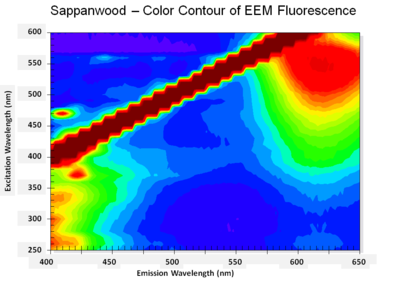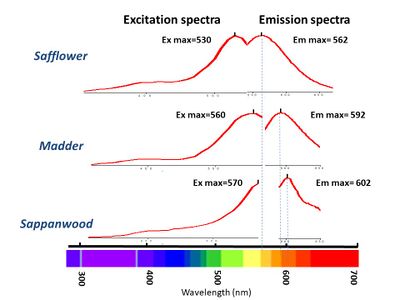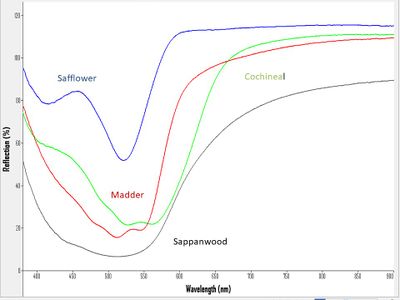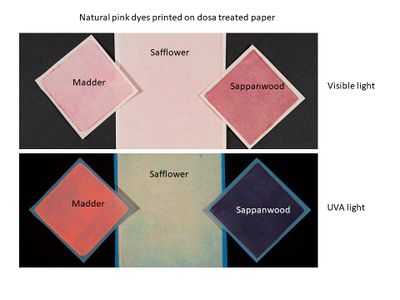Difference between revisions of "Category:Sappanwood: Ukiyo-e colorant"
| (31 intermediate revisions by 2 users not shown) | |||
| Line 1: | Line 1: | ||
| − | |||
| − | [[ | + | [[File:SC347460.jpg|right|400px|link=Harunobu, The Tenth Month, from an untitled series of Twelve Months, 11.20124|The Tenth Month by Suzuki Harunobu]] |
| + | <font size="3">'''[[Brazilwood dye|Sappanwood]]'''</font> 蘇芳 (''suō''): A red dye extracted from several tropical trees, such as ''Paubrasilia echinata'', commonly known as brazilwood from Brazil and ''Biancaea sappan'', commonly known as sappanwood from Southeast Asia. Its principal colorant is [[brasilin]], a hydroxyanthraquinone, that gives a deep red to brownish color when it is oxidized to form brasilein. | ||
| + | |||
| + | Sappanwood has been detected but the use of it appears to have been infrequent. Due to its sensitivity to pH, sappanwood can be manipulated to produce a range of colors as pink, red, or oranges. It is unknown if printers adjusted the pH to create a range of colors. Evidence of pH manipulation is difficult to extrapolate from the prints | ||
| + | themselves since many of the examples have discolored to a dull pinkish brown due to fading and/or ageing. | ||
| + | |||
| + | '''For additional information see:''' [[Brazilwood dye|Sappanwood]], [https://powo.science.kew.org/taxon/urn:lsid:ipni.org:names:481889-1 ''Biancaea sappan'' (Kew)] | ||
| + | <br> | ||
| + | <br> | ||
| + | |||
| + | == Examples of Sappanwood in Ukiyo-e Prints == | ||
| + | |||
| + | {| class="wikitable" style="display: inline-table;font-size:90%;text-align:center;width:15%" | ||
| + | |[[File:11.13225-pt8-detail.png|200px|link=Toshinobu, Actors Matsushima Hyôtarô as the Courtesan Senzai and Nakamura Ujûrô and Nanboku Magotarô as Samurai, 11.13225]] | ||
| + | |- | ||
| + | | | ||
| + | [[File:Indigo FORS.JPG|200px]]<br>[[Toshinobu, Actors Matsushima Hyôtarô as the Courtesan Senzai and Nakamura Ujûrô and Nanboku Magotarô as Samurai, 11.13225|Pt 8: Hand colored<br>Okumura Toshinobu, 11.13225]] | ||
| + | |} | ||
| + | |||
| + | {| class="wikitable" style="display: inline-table;font-size:90%;text-align:center;width:15%" | ||
| + | |[[File:11.30137-pt1-detail.png|200px|link=Komatsuken, Young Man as the Bodhisattva Monju, 11.30137]] | ||
| + | |- | ||
| + | | | ||
| + | [[File:Indigo FORS.JPG|200px]]<br>[[Komatsuken, Young Man as the Bodhisattva Monju, 11.30137|Pt 1: Printed<br>Komatsuken, 11.30137]] | ||
| + | |} | ||
| + | |||
| + | {| class="wikitable" style="display: inline-table;font-size:90%;text-align:center;width:15%" | ||
| + | |[[File:11.25669-pt2-detail.png|200px|link=Eisen, Minazuru-hime as Ono no Komachi and Benkei as Kisen Hôshi, from the series Characters from the Life of Ushiwaka as the Six Poetic Immortals, 11.25669]] | ||
| + | |- | ||
| + | | | ||
| + | [[File:Indigo FORS.JPG|200px]]<br>[[Eisen, Minazuru-hime as Ono no Komachi and Benkei as Kisen Hôshi, from the series Characters from the Life of Ushiwaka as the Six Poetic Immortals, 11.25669|Pt 2: Printed<br>Keisai Eisen, 11.25669]] | ||
| + | |} | ||
| + | |||
| + | {| class="wikitable" style="display: inline-table;font-size:90%;text-align:center;width:15%" | ||
| + | |[[File:11.21066-pt4-detail.png|200px|link=Shinsai, Chapters 16–18, from the series The Tale of Genji, 11.21066]] | ||
| + | |- | ||
| + | | | ||
| + | [[File:Indigo FORS.JPG|200px]]<br>[[Shinsai, Chapters 16–18, from the series The Tale of Genji, 11.21066|Pt 4: Printed<br>Ryūryūkyo Shinsai, 11.21066]] | ||
| + | |} | ||
| + | |||
| + | {| class="wikitable" style="display: inline-table;font-size:90%;text-align:center;width:15%" | ||
| + | |[[File:11.20413-pt5-detail.png|200px|link=Hokusai, Stone, from the series Three Pictures for a Children's Hand Game, 11.20413]] | ||
| + | |- | ||
| + | | | ||
| + | [[File:Indigo FORS.JPG|200px]]<br>[[Hokusai, Stone, from the series Three Pictures for a Children's Hand Game, 11.20413|Pt 5: Printed<br>Katsushika Hokusai, 11.20413]] | ||
| + | |} | ||
| + | |||
| + | == Analysis == | ||
| + | Excitation Emission Matrix (EEM) spectroscopy can easily identify the organic reds: [[:Category:Safflower: Ukiyo-e colorant|safflower]], [[:Category:Madder: Ukiyo-e colorant|madder]], and sappanwood. Sappanwood does not fluoresces under UVA radiation and produces a unique EEM pattern. | ||
| + | |||
| + | |||
| + | <gallery mode="packed" heights="200px" style="text-align:left"> | ||
| + | Sappanwood color.PNG|<center>EEM plot for Sappanwood</center> | ||
| + | Red EEM plots.jpg|<center>3D EEM plots for Red references</center> | ||
| + | Red EmEx curves.jpg|<center>Overlay of EEM curves for Red references</center> | ||
| + | FORS of reds.jpg|<center>Overlay of FORS spectra for Red references</center> | ||
| + | Red UVVis images.jpg|<center>Visible light and UVA for Red references</center> | ||
| + | </gallery> | ||
| + | |||
| + | ==Images of Sappanwood == | ||
<gallery> | <gallery> | ||
| − | Sappsnwood trees.JPG|Sappanwood ('' | + | Sappsnwood trees.JPG|Sappanwood (''Biancaea sappan'') |
| − | + | File:Red bud_suo.jpg|Chips of Sappanwood | |
| − | File:Red bud_suo.jpg| | + | File:12 Sappanwood.jpg|Sappanwood |
| − | File:12 Sappanwood.jpg|Sappanwood | ||
| − | |||
| − | |||
</gallery> | </gallery> | ||
| − | == | + | ==List of Prints == |
| − | + | Below is a list of prints where sappanwood was detected. | |
| − | |||
Latest revision as of 23:32, 24 May 2024
Sappanwood 蘇芳 (suō): A red dye extracted from several tropical trees, such as Paubrasilia echinata, commonly known as brazilwood from Brazil and Biancaea sappan, commonly known as sappanwood from Southeast Asia. Its principal colorant is Brasilin, a hydroxyanthraquinone, that gives a deep red to brownish color when it is oxidized to form brasilein.
Sappanwood has been detected but the use of it appears to have been infrequent. Due to its sensitivity to pH, sappanwood can be manipulated to produce a range of colors as pink, red, or oranges. It is unknown if printers adjusted the pH to create a range of colors. Evidence of pH manipulation is difficult to extrapolate from the prints themselves since many of the examples have discolored to a dull pinkish brown due to fading and/or ageing.
For additional information see: Sappanwood, Biancaea sappan (Kew)
Examples of Sappanwood in Ukiyo-e Prints
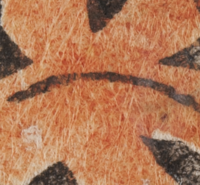
|
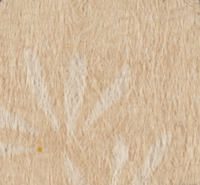
|

|
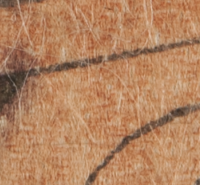
|
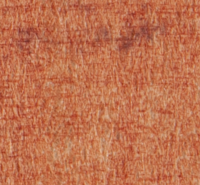
|
Analysis
Excitation Emission Matrix (EEM) spectroscopy can easily identify the organic reds: safflower, madder, and sappanwood. Sappanwood does not fluoresces under UVA radiation and produces a unique EEM pattern.
Images of Sappanwood
List of Prints
Below is a list of prints where sappanwood was detected.
Pages in category "Sappanwood: Ukiyo-e colorant"
The following 37 pages are in this category, out of 37 total.
B
E
- Eisen, Kawasaki, No. 3 from an untitled series of the Fifty-three Stations of the Tôkaidô Road, 11.25617
- Eisen, Minazuru-hime as Ono no Komachi and Benkei as Kisen Hôshi, from the series Characters from the Life of Ushiwaka as the Six Poetic Immortals, 11.25669
- Eisen, The Song Evening Mist at Asama Peak, on Scrap-paper Fabric with an Itchû-bushi Libretto, from the series A Modern Pine Needle Collection, 11.17878
H
- Harunobu, Courtesan Watching Two Kamuro Make a Snow Dog, 21.4463
- Harunobu, Osen of the Kagiya and a Young Man with a Cat, 11.19496
- Harunobu, Parody of Saigyô Hôshi: Courtesan Looking at a Screen Painting of Mount Fuji, 11.19431
- Harunobu, The Tenth Month, from an untitled series of Twelve Months, 11.20124
- Harunobu, Young Woman Tuning a Shamisen, 06.479
- Hiroshige I, Naitô Shinjuku, Yotsuya, from the series One Hundred Famous Views of Edo, 11.35823
- Hiroshige I, Pine of Success and Oumayagashi, Asakusa River, from the series One Hundred Famous Views of Edo, 11.17029
- Hokkei, Goat Standing by a Plum Tree, 21.9277
- Hokkei, Ômori, from the series Souvenirs of Enoshima, a Set of Sixteen, 11.19845
K
- Kiyomasu II, Actors Ôtani Hiroji II as Washi no Chôkichi and Arashi Tominosuke as Tarui Osen, 21.5458
- Kokan, Couple Cooling Off on a Garden Bench, 11.19524
- Komatsuken, Courtesan Parading with Two Kamuro, 11.19711
- Komatsuken, Young Man as the Bodhisattva Monju, 11.30137
- Komatsuken, Young Woman as the Bodhisattva Fugen, 11.30136
- Koryusai, Descending Geese at Mimeguri, from the series Fashionable Eight Views of Edo, 11.14627
- Kunisada, Poem by Ariwara no Narihira Ason: (Actor Ichikawa Danjûrô VIII as) Seigen, from the series Comparisons for Thirty-six Selected Poems, 11.42663
- Kunisada, Young Woman Pointing and Giggling, from the series Types of the Floating World Seen through a Physiognomist's Glass, 34.471
- Kuniyoshi, Actor Ichikawa Kodanji IV as the Ghost of Asakura Tôgo, 11.30460
- Kuniyoshi, Hosokute: Horikoshi Dairyô, from the series Sixty-nine Stations of the Kisokaidô Road, 11.28766
- Kuniyoshi, Takeout Sushi Suggesting Ataka, from the series Women in Benkei-checked Fabrics, 11.36360
- Kuniyoshi, Tsumagome: Abe no Yasuna and the Fox Kuzunoha, from the series Sixty-nine Stations of the Kisokaidô Road, 11.41803
S
- Sharaku, Actor Osagawa Tsuneyo II as Ippei's Older Sister Osan, 11.14673
- Sharaku, Actor Osagawa Tsuneyo II as Ippei's Older Sister Osan, 11.14674
- Sharaku, Actor Osagawa Tsuneyo II as Ippei's Older Sister Osan, 21.7244
- Shigenobu I, Puppy Playing with a Ball, 21.9257
- Shinsai, Chapters 22–24, from the series The Tale of Genji, 11.20034
- Shinsai, Chapters 25–27, from the series The Tale of Genji, 21.9264
- Shunkō, Actors Nakamura Nakazô I and Ôtani Hiroji III, 11.2014


